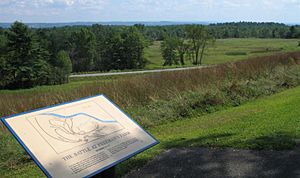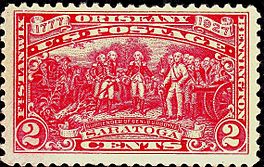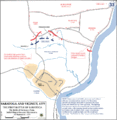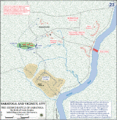Battle of Saratoga facts for kids
Quick facts for kids Battles of Saratoga |
|||||||
|---|---|---|---|---|---|---|---|
| Part of the American Revolutionary War Saratoga campaign |
|||||||
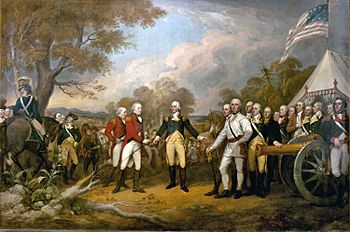 Surrender of General Burgoyne by John Trumbull, 1822 Depicted at center are General John Burgoyne surrendering to General Horatio Gates, who refused to take his sword. The painting hangs in the United States Capitol Rotunda. |
|||||||
|
|||||||
| Belligerents | |||||||
|
|||||||
| Commanders and leaders | |||||||
| Strength | |||||||
| 9,000 (first battle) over 12,000 (second battle) over 15,000 (at time of surrender) |
7,200 (first battle) 6,600 (second battle) |
||||||
| Casualties and losses | |||||||
| 90 killed 240 wounded |
440 killed 695 wounded 6,222 captured |
||||||
The Battles of Saratoga were a major turning point in the American Revolutionary War. These important battles happened in late 1777. They were actually two separate fights: the Battle of Freeman's Farm on September 19, and the Battle of Bemis Heights on October 7.
The Americans were led by General Horatio Gates. The British forces were commanded by General John Burgoyne. On October 17, General Burgoyne surrendered his army of nearly 6,000 British soldiers. This big American victory helped France decide to join the war and support the Continental Army. It also led France to officially recognize the United States as an independent country.
Contents
How the Saratoga Campaign Started
In early 1777, General William Howe, a British commander, wanted to attack Philadelphia. He hoped this would crush the American government. At the same time, General John Burgoyne in Canada had a plan. He wanted to move south through New York and meet General Howe in Albany. This would cut off the New England colonies from the others.
London approved both plans. Burgoyne began his march down the Hudson River valley from Canada. He divided his army into two groups. One group, led by Colonel Barry St. Leger, moved from Lake Ontario down the Mohawk Valley. They attacked the Americans at Fort Stanwix.
The Americans sent troops to help the fort. The second group, led by Benedict Arnold, forced the British away from the fort. St. Leger's group then retreated back to Lake Ontario. Burgoyne continued south with his main army of about 7,000 British and Hessian soldiers. About 500 Native American allies also joined him.
Burgoyne told his Native American allies to attack the American enemy. He said they should not harm women, children, or anyone who did not fight back. However, some civilians were still harmed. One event made many colonists very angry. A young woman named Jane McCrea was killed by some of Burgoyne's Native American allies. Burgoyne did not punish the person responsible. This made many people realize he could not protect even friendly colonists. News of this spread quickly. Many Americans who had been neutral then decided to fight against the British. This story even reached England, where Edmund Burke spoke out against the British using Native American allies.
Battle of Freeman's Farm
General Howe had captured Philadelphia, but it took him a long time. Because of this, he could not send any troops north to help Burgoyne. On September 19, Burgoyne attacked the Americans. The Americans were dug in on Bemis Heights near Saratoga.
The fighting happened again at Freeman's Farm. This time, American riflemen led by Daniel Morgan were there. American marksmen aimed for British and Hessian officers. This was meant to cause confusion among the British forces. Burgoyne lost about 600 soldiers in this battle. He said he won, but the Americans still held their ground.
Battle of Bemis Heights
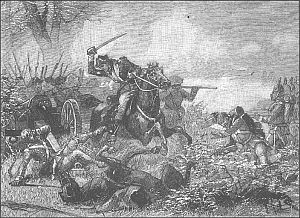
Burgoyne tried to attack the Americans again on October 7, but he failed. The Americans fought hard and held their positions. A strong counterattack led by Benedict Arnold pushed the British back even further. Eventually, the British retreated back to Saratoga.
This second battle cost Burgoyne another 600 soldiers. The Americans lost fewer than 150. Burgoyne's army was now surrounded by a much larger and growing American army. On October 13, 1777, Burgoyne asked for a Ceasefire. Horatio Gates, the American commander, demanded Burgoyne's surrender.
Burgoyne tried to delay, but Gates's terms were tough. Finally, Gates offered slightly better terms. On October 17, Burgoyne's army officially surrendered.
British Surrender
General Burgoyne surrendered his entire army of 5,752 soldiers. He also gave up 42 cannons, 7,000 muskets, and all his supplies. The British officers were separated from their men and allowed to keep their pistols. They were released on their word not to fight again.
General Gates invited Burgoyne to dinner, and they were friendly. They each raised a toast to the other's leader. The British and Hessian soldiers were marched to Boston. According to the agreement, they were supposed to return to England, promising not to fight in the war again. However, the American Congress later changed these terms. Many soldiers were sent to prisons in the colonies to wait until the war ended.
Interesting Facts About the Battle of Saratoga
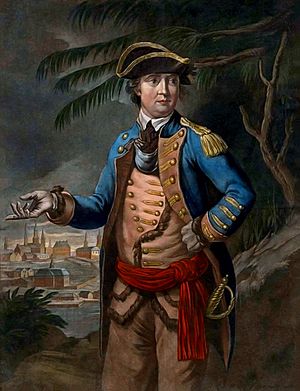
- Benedict Arnold was a hero at the Battles of Saratoga, but he later became a spy for the British.
- About 440 British soldiers and 90 American soldiers died during both battles.
- The victories at Saratoga were a major turning point in the war. France felt confident enough to support the Americans after their win. They formed an alliance with America in 1778.
- To celebrate the victory at Saratoga, George Washington declared that the first national Thanksgiving day would be on December 18, 1777.
Images for kids
-
General John Burgoyne was referred to by some as "Gentleman Johnny" for his manners (portrait by Sir Joshua Reynolds, c. 1760)
-
General Horatio Gates, portrait by Gilbert Stuart
-
Troop positions and initial movements at the Battle of Bemis Heights. This map was made by Rufus Putnam, who commanded the 5th Massachusetts Regiment.
-
Boot Monument, showing Arnold's injured leg
-
View of the battlefield from the visitor center of Saratoga National Historic Park
See also
 In Spanish: Batalla de Saratoga para niños
In Spanish: Batalla de Saratoga para niños


